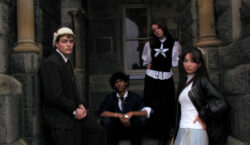The past several years have seen a resurgence of interest in the American blaxploitation films of the 1970s. Spanning from the since-clich?d Shaft to the slapstick comedy of Rudy Ray Moore’s Dolomite, blaxploitation movies were by and for urban African-American youth, particularly men. In his 1993 book Makes Me Wanna Holler, Nathan McCall describes just how potently he and his friends connected with the blaxploitation classic Superfly. Issues of urban poverty, patent racism and the desire for a better life were all addressed through traditional American plot formats of a renegade hero battling the corrupt, destabilizing forces of a standard enemy.
From innumerable recent movies on drug-chic (start at Blow and move backwards) to the straight blaxploitation adaptation Jackie Brown, tales of pimps, pushers and run-ins with the law are holding the fascination of Hollywood’s more creative minds. The trend will no doubt continue until Tarantino, Depp and their cohorts decide that present-day America is a canvas worthy of their attention. Until then, the phenomenon begs the question: Why?
How to view blaxploitation films is a delicate subject. A postmodern sense of irony will serve you well. It is quite ironic in itself, if not downright offensive, that the poverty-stricken black culture of the 1970s brought on by post-war white flight can be such an object of fascination for the children and grandchildren of those who fled the cities that provide the background for this archetype. But the current obsession cannot be denied, and should be examined in its proper context as a pop phenomenon.
This resurging interest is due in part to traditional American pop culture’s recent fall into bland, non-offensive inanity; witness the rise of Britney, Dawson’s Creek and Tommy Hilfiger. The “vanilla suburbs” have always needed an outlet, and they have invariably found it in an embrace of black culture. For the most part, this was limited to a musical embrace. Jazz was the music of choice for young whites, followed by rock and eventually hip-hop. In every case, the style was co-opted by whites, and melded into the bastard canon of American pop.
Consider then this embrace of blaxploitation as yet another example of black culture being adopted by white audiences, and subsequently diluted into innocuousness. If that is the fate of this culture, we feel it is necessary to go back and take a look at what the big deal is about?why were these films so different and at the same time so familiar to general American trends that the descent to banality was inevitable?
When critiquing these films, any sense of middle-class morality quickly proves to be a worthless compass. Upon learning that her soon-to-be treacherous brother has started dealing coke again to pay the bills in Foxy Brown, Pam Grier is disappointed in an inconvenienced, “oh-you-didn’t-just-do-that-did-you” kind of way. Drugs are clearly addressed within their social context, and in any one film, they may become a well-honed power or a force of wanton destruction. The producers were fully aware of the double-edged sword of an indescribable high vs. lunatic craving, desire for prosperity vs. terminal habits and violence. One explanation for the blaxploitation renaissance could be the U.S. government’s failure to have sufficiently dealt with the problem in years past, when crack epidemics were destroying cities. Forcing American society to square off against itself doesn’t seem to have solved the issue then, leaving Hollywood (and consequently America) still stuck in the substance abuse-analysis equivalent of the oral stage.
As far as women’s lib, time hath wrought many changes. In Black Belt Jones, Jim Kelly (of Enter the Dragon fame) makes rather forward advances on the female lead. Her only recourse is to fight fire with fire, and she promptly shoots back the claim: “My cookie would kill you.” American women of the 21st century typically have career opportunities beyond the realm of said “cookie,” so score one for progress.
This resurrection has no doubt been reflected in general pop culture trends. Among young white suburbanites, the “pimp” remains an object of fascination, if not downright aspiration. Witness the recent documentary American Pimp; in one scene, passersby are asked about their images of the pimp. Invariably, for older generations the pimp represents the worst in society?someone who exploits women for their own personal gain. Many younger people had different views?the pimps as kings of the mountain. They, after all, have money, power and sex; what then makes pimps any different from any other person in pursuit of the American dream? They may exploit women and break laws, but hey, they do it without having to sit behind a desk pushing paper five days a week.




